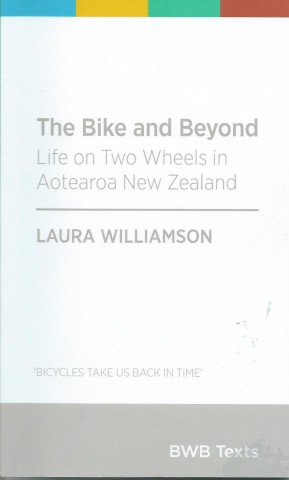
Review of:
Williamson, Laura (2016) The Bike and Beyond: life on two wheels in Aotearoa New Zealand. BWB texts. $15 softback, $5 eBook.
Wanaka based, but of Canadian origins, Laura Williamson has been writing about biking in NZ for a couple of decades, including contributing to the MTB magazine Spoke. She's concerned that despite the growth in recreational cycling, we're still wedded to our cars for commuting and utility trips. "Biketivism", or social action that challenges the primacy of the car, has been around for while, as CAN's existence demonstrates, but the term has gained currency with the release of Fredrik Gertten's Bikes vs Cars. She notes the 2009 Auckland Harbour Bridge walk/cycle protest as a Kiwi example of Biketivism.
Athough NZ doesn't think of itself as a "cycling" nation, plenty of Kiwis have gone abroad to make their names on two wheels, for example Alex "De Snor" Revell who earned a cult following among Belgian cyclocross fans.
Williamson structures her book into essays on towns (Ōamaru, Christchurch, Wellington), types of cycling (Frocks on Bikes, Mountain Biking), as well as Tour de France racer Jack Bauer and her own experience of biking the Tour de Mont Blanc.
Ōamaru hosted NZ's first recorded bicycle race in 1889, and in recent times has seen a resurgence of Victorian style cycling with the penny farthing based Ōamaru Ordinary Cycle Club, nicely complementing the Ōamaru's emergent Steam Punk culture. Ōamaru was home to early biketivist and feminist Alice Burn, who pioneered an early version of the Alps 2 Ocean by biking from Ōamaru to Hokitika in 1893.
Post-Quake Christchurch is a case study in rebuilding a cycling network in a city that was once nicknamed "Cyclopolis". On one hand the city had a "clean slate", on the other hand drivers frustrated by ubiquitous road works resented space being given to biking. A 2013 letter to the Press claimed that "The cycling community are bludgers in grand scheme of road use". However the quakes dispelled "the myth that cyclists represent a 'small section' of Christchurch's residents", and indeed in the immediate aftermath of the quake, bikes were the most effective way to get around. And the 2013 census showed an increase in biking to work, led by Beckenham with 16% mode share, comparable to Cambridge in England and Haarlemmermeer in the Netherlands.
Williamson notes that Wellington, although not topographically suited to biking, and not yet well supplied with bike lanes, has been a hotbed of innovative cycling culture. She identifies Ciclovia, Frocks on Bikes, Wellington Cycling Chic, Bicycle Junction and their Need for Tweed rides, and the strong fixie culture.
"Woman are often referred to as the indicator species for the cycling health of a place", but typically two thirds of bike riders in NZ are men. Dress is often seen as a barrier by women wanting to bike, so Williamson documents the growth of Frocks on Bikes, which has the aim of normalising biking in everyday, even stylish, clothing with the mantra "the bicycle has no uniform".
Mountain biking began in the US with a few hoons taking beach cruisers down Mt Tamalpais, closely followed in NZ. For most of its history track construction has been an undercover activity, with enthusiasts creating bike tracks little hampered by the need for official approval. This has changed with the growth of Nga Haerenga, NZs network of cycle trails, making mountain biking a "Key" part of our tourist economy.
Bike and Beyond has something in common with Bella Bathurst's Bicycle Book (2011) but it packs a lot into 98 pages, and should be read by anyone interested in cycling culture and history. It lacks pictures, but the prose easily makes up for this. There are a few minor errors (the Wellington Cycling Framework was produced by Wellington City Council, not Greater Wellington Regional Council). The sources list provides an excellent opportunity to extend your reading.
Williamson reminds us that "the bicycle is a time machine, a link to the past. But sometimes the bicycle also feels like a link to the future - not the future we once imagined, the one with flying cars and replicators, but more like the one the Victorians might have pictured: streets crowded with bikes, strange ones, of all kinds, fat and thin, tall and short, on a mission, out for a roll, loaded down, parked up, going places." Let's work for that future!
-Alastair Smith, author of Everyday Cycling in Aotearoa New Zealand (2012)
